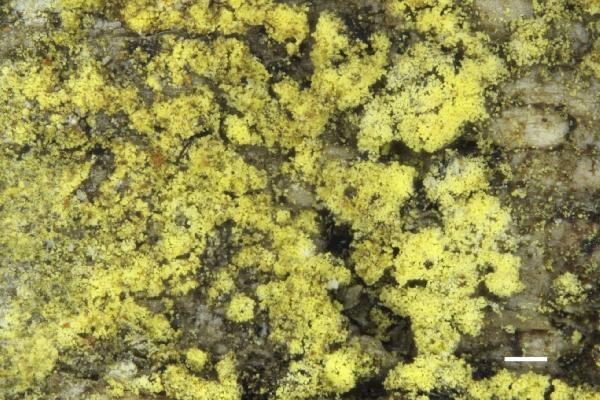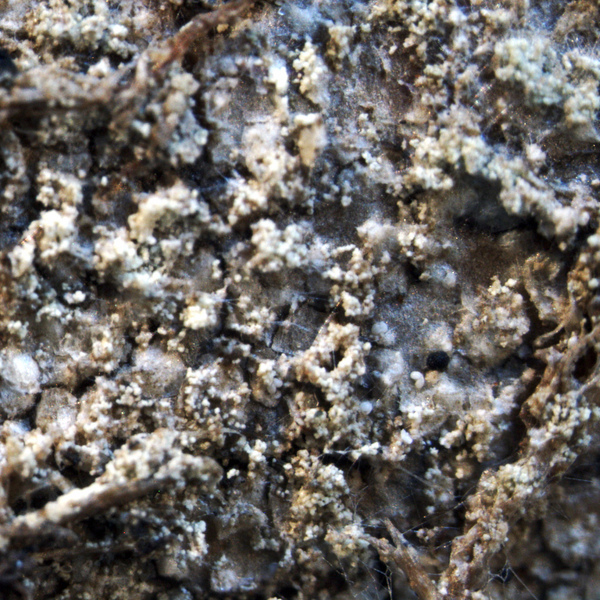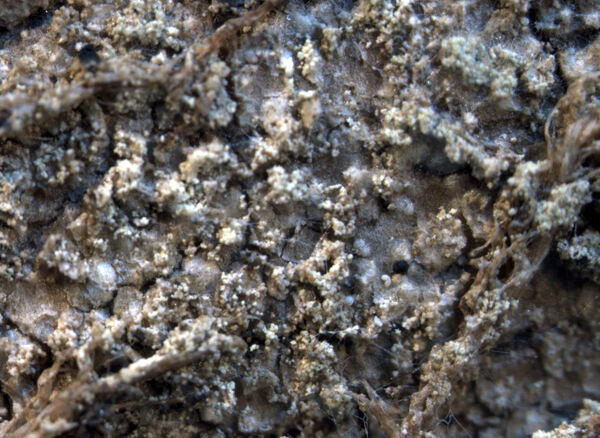Rinodina sheardii Tønsberg
Bryologist, 95, 2: 216, 1992
Synonyms:
Distribution:
Description: Thallus crustose, endosubstratic or thinly episubstratic, often indistinct, continuous to areolate, the areoles flat to slightly convex, c. 0.4 mm wide, contiguous or becoming fused, glaucous or rarely whitish, with yellowish to pale brown, discrete or sometimes confluent, irregularly rounded, more or less convex, up to 0.5 mm wide soralia, the soredia up to 25 µm thick, the exposed part of external soredia with a brown pigment in the hyphal walls. Apothecia lecanorine, sparse to abundant, up to 0.5 mm across, broadly attached, with a flat, dark brown to black disc and a smooth to rarely sorediate thalline margin. Thalline exciple 60-70 µm wide laterally, filled with crystals; proper exciple c. 15 µm wide laterally, expanded to c. 30 µm in upper part; epithecium red-brown, K-; hymenium colourless, up to 100 µm high; paraphyses c. 2 µm thick at mid-level, the apical cells hardly swollen, up to 3 µm wide; hypothecium brown, up to 80 µm high, inspersed with oil droplets. Asci 8-spored, clavate, the K/I+ blue tholus penetrated by a faintly amyloid apical cushion with parallel or diverging flanks, the wall K/I-, surrounded by a K/I+ blue outer layer, Lecanora-type. Ascospores 1-septate, brown, ellipsoid, 16-30(-35) x 8-17 µm, Physcia-type, with a smooth wall and a prominent torus. Photobiont chlorococcoid. Spot tests: soralia (when appearing yellow) K-, C+ orange, KC-, P-. Chemistry: zeorin, secalonic acid A (major) thiomelin, 5,7-dichloro-8-hydroxy-2-methoxy-1,3-dimethylxanthone (minor), sometimes with traces of atranorin.Note: a rare, sorediate, corticolous species with optimum in the montane belt on broad-leaved trees, in humid places such as the spray zone of waterfalls, known from a few localities in the Alps (Austria, Slovenia, Switzerland); to be looked for in the Italian Alps.
Growth form: Crustose
Substrata: bark
Photobiont: green algae other than Trentepohlia
Reproductive strategy: mainly asexual, by soredia, or soredia-like structures (e.g. blastidia)
Most common in areas with a humid-warm climate (e.g. most of Tyrrenian Italy)

Predictive model
Growth form: Crustose
Substrata: bark
Photobiont: green algae other than Trentepohlia
Reproductive strategy: mainly asexual, by soredia, or soredia-like structures (e.g. blastidia)
Most common in areas with a humid-warm climate (e.g. most of Tyrrenian Italy)

Predictive model
 INDEX FUNGORUM
INDEX FUNGORUM
 GBIF
GBIF





